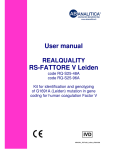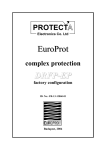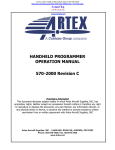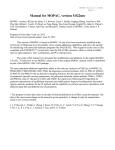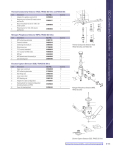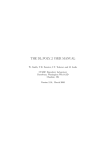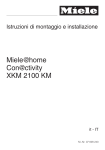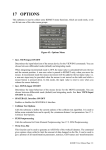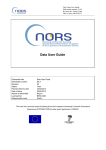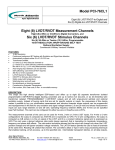Download DLPROTEIN 1.2 User Manual - KIST computational science
Transcript
DLPROTEIN 1.2 User Manual Contents Overview 1 1 Building the molecular topology 3 1.1 dlgen : : : : : : : : : : : : : : : : : : : 1.1.1 dlgen input les : : : : : : : : : : 1.1.2 Editing the pdb le : : : : : : : : 1.1.3 Adding entries to the MBBT le 1.1.4 Adding entries to the PS le : : : 1.2 merge eld : : : : : : : : : : : : : : : : 2 The molecular dynamics code 2.1 Integration Algorithms : : : : 2.1.1 NVT ensemble : : : : 2.1.2 NPT ensemble : : : : 2.1.3 Constraints treatment 2.2 RESPA implementation : : : 2.3 Scanning neighbors : : : : : : : : : : : : : : : : : : : : : : : : : : : : : : : : : : : : : : : : : : : : : : : : : : : : : : : : : : : : : : : : : : : : : : : : : : : : : : : : : : : : : : : : : : : : : : : : : : : : : : : : : : : : : : : : : : : : : : : : : : : : : : : : : : : : : : : : : : : : : : : : : : : : : : : : : : : : : : : : : : : : : : : : : : : : : : : : : : : : : : : : : : : : : : : : : : : : : : : : : : : : : : : : : : : 5 : 6 : 6 : 10 : 11 : 14 : : : : : : 16 16 17 19 20 21 24 2.3.1 Memory optimization on scalar workstation 2.3.2 CPU optimization on scalar workstation : : 2.4 The Smooth Particle Mesh Ewald method : : : : : 2.4.1 Choosing the SPME variables : : : : : : : : : : : : : : : : : : : : 3 Other dierences between DLPOLY and DLPROTEIN : : : : : : : : : : : : : : : : : : : : : : : : 3.1 Non-bonded interactions : : : : : : : : : : : : : : : : : : : : : : : : 3.2 Interpolation, spline or direct evaluation of the Van der Waals interactions : : : : : : : : : : : : : : : : : : : : : : : : : : : : : : : : 3.3 Refolding of molecules : : : : : : : : : : : : : : : : : : : : : : : : : 3.4 Constraints treatment : : : : : : : : : : : : : : : : : : : : : : : : : 3.5 Shifted Van der Waals interactions and long range corrections : : : 3.6 Smoothing the Van der Waals interactions at the cut-o : : : : : : 3.7 Hydrogen bond detection : : : : : : : : : : : : : : : : : : : : : : : : 3.8 Short and long OUTPUT les : : : : : : : : : : : : : : : : : : : : : 3.9 I/O format of trajectory data : : : : : : : : : : : : : : : : : : : : : 3.10 Include les : : : : : : : : : : : : : : : : : : : : : : : : : : : : : : : 3.11 T3E communication routine : : : : : : : : : : : : : : : : : : : : : : 3.12 Directives in the CONTROL le : : : : : : : : : : : : : : : : : : : : 3.13 Directives in the FIELD le : : : : : : : : : : : : : : : : : : : : : : 3.14 Directives in the Makele : : : : : : : : : : : : : : : : : : : : : : : 3.15 Examples : : : : : : : : : : : : : : : : : : : : : : : : : : : : : : : : References 24 25 26 27 29 29 29 30 30 31 31 32 32 32 33 33 34 36 37 39 41 i Overview DLPROTEIN is a molecular dynamics package written by Simone Melchionna and Stefano Cozzini in the framework of the Italian Institute for the Physics of Matter (INFM), Network on \MD simulation of biosystems". DLPROTEIN is a development of the original general purpose Molecular Dynamics code DLPOLY written at Daresbury Lab (UK) by William Smith and Tim R.Forester. The motivation underlying the development of DLPROTEIN has been to specialize the original MD code to deal more specically with biological molecules, with particular focus on proteins, and with high eciency and low memory requirements for scalar architectures. DLPROTEIN has been realized with the contributions of several people who have partecipated in the project in dierent percentages. Amonst others we wish to thank Antonella Luise as a coauthor of dlgen and for designing the link cell algorithm for generic periodic boundary conditions, Maddalena Venturoli as a coauthor of dlgen and for many useful insights in the code, Marco Pierro, as the author of the merge eld utility, from the Physics Department of the University \La Sapienza" of Rome. A special thanks is for Georges Destree, of the Universite Libre de Bruxelles, who has managed several parallel xes and new algorithms in the code. During the development of DLPROTEIN collaboration and support from Giovanni Ciccotti (University of Rome "La Sapienza"), Mattia Falconi, Alessandro Desideri (University of Rome "Tor Vergata") and Mauro Ferrario (University of 1 Modena) are kindly ackowledged. We thank Tom Darden for providing us with the SPME original routines. The following manual is intended as an addendum to the DLPOLY 2.0 Manual [1]. The reader is referred to the DLPOLY manual for general explanations about the code philosophy and technical details whereas the present documentation reports only modications and addenda to the original DLPOLY package. 2 Chapter 1 Building the molecular topology Building the molecular topology of molecules is done by the utility build all . The program build all takes care of building up in sequence a system composed of one or more molecules. build all is a fortran program that calls the two dierent utilities called dlgen and merge eld . The three programs build all , dlgen , and merge eld are provided with a Makele in the build-topology directory. Once they are compiled (by simply executing the \make" command), these utilities can be run alltogether, by running the driver build all , or singularly. dlgen converts a Protein Data Bank le (pdb le) into the les CONFIG and FIELD that contain respectively the topology and conguration of a single molecule. Subsequently merge eld merges each FIELD le produced by dlgen , eventually with other prebuilt FIELD les, into a global FIELD le. Theese utilities have been implemented thinking in terms of aminoacidic systems (e.g.proteins) as the main goal, and it is able to treat force elds of the type CHARMm22 and GROMOS87 (37c4 parameter set). Due to the general combination rules of the CHARMm22 force eld, dlgen works for proteins, proteins+metallic groups (e.g. heme group), phospholipids, sugars, and so on, i.e. any kind of entry can be safely added to the molecular database. Viceversa due to the more complex rules 3 adopted by the GROMOS87 force eld (e.g. the way the dihedrals are dened for sugars), the actual version of dlgen works only for proteins, eventually in presence of metallic groups. The reader may ask the authors to obtain a non-standard version of dlgen to treat dierent systems within the GROMOS87 force eld. An easy way to run the build all utility is to make the following steps : 1. Link (or Copy) in your working directory the three executables produced by the compilation, together with the database les (MBBT and PS les, as explained in the following) needed by dlgen to run. In the working directory you need to have also the PDB les to be converted or any previously produced FIELD le the needs to be merged. 2. Run the build all utility and answer a few questions. Infos and warnings will be issued as the molecular construction proceeds. The dlgen utility supports the \United Atom" (UA) scheme (i.e. CH, CH2 and CH3 group are treated as united groups) when using the GROMOS87 force eld, and the \All Hydrogens" (AH) scheme (polar and non-polar hydrogens are always explicitely treated) when using the CHARMm22 force eld. dlgen uses an internal database to store the parameter set (PS) and the molecular building block topology (MBBT), e.g. the structure of the elementary units, such as the amino acids. The PS le stores: - atomic names, masses and connection tables; - bond reference list, spring constants and equilibrium distances; - angle reference list, spring constants and equilibrium angles; - dihedral reference list, multiplicity, force constants and phases; - Van der Waals parameters. The MBBT les stores the group names, internal connectivity and atomic charges. In table 1.1 we report the database le names. 4 GROMOS87 CHARMM22 PS le name MBBT le name PS gromos37c.ff MBBT gromos37c.ff PS charmm22.ff MBBT charmm22.ff Table 1.1: Database le names for the GROMOS87 and CHARMM22 force elds. PS : parameter set, MBBT : molecular bulding block topology 1.1 dlgen The dlgen utility must be run with a pdb le that species a single molecule, i.e. each atom of the molecule must be globally connected by chemical bonds. dlgen performs in order the following actions : 1. Read in the Brookhaven pdb le and the MBBT les. 2. Generate the sequence of each block by merging the informations in the pdb and MBBT les (edtgen routine). 3. If hydrogen atoms are missing, add them with the proper chemical geometry and connectivity, as specied in the MBBT database (hgen routine). 4. Read in the PS and FF.dat les. 5. Complete connectivity by adding the missing links (e.g. link aminoacid to aminoacid, complete the aromatic rings, and so on). 6. Generate bond, angle and dihedral list, together with the Van der Waals interactions (generic and I-IV types). 7. Dumps out the FIELD le. 5 1.1.1 dlgen input les dlgen uses the following input data : Brookhaven pdb le, containing atomic and molecular names and atomic conguration. This le must be edited and modied, as explained later on. FF.dat le, containing the topology title, constraints-vs.-harmonic springs treatment and energy units. The constraints directives are : directive: constrain string meaning: where string can be equal to all : all bonds are constrained h : only bonds concerning hydrogens are constrained none : all bonds are harmonic specialbond n1 n2 n3 ::: list of residues to treat harmonically. units string Output units as expressed in the FIELD le. Admitted values for string are \eV", \kJ", \kcal" and \internal' for using dlpoly internal units. Moreover the user must insert data as requested by the program in run time at standard input. 1.1.2 Editing the pdb le Before running the dlgen program the pdb le must be edited and a few changes must be applied. dlgen uses each building block specied in the MBBT database as an independent unit so that in principle there is no dierence when treating a sequence of amino acids or a sequence of generic building blocks. In fact the intrablock topology is specicied in the MBBT database, while dlgen uses the geometry specied in the pdb le to construct the interblock topology. 1. Terminal groups labels Usually the peptidic sequence begins (or ends) with a NH3 group. The pdb atomic label relative to the starting nitrogen atom must be changed from the original pdb label into the new NTER label and eventually if 6 any hydrogen is specied (i.e. the user does not require generation of positions hydrogens from scratch) the hydrogen atoms must have the labels HTn, with n=1, 2, 3. Hydrogen atoms attached to NTER must follow in order. In case the N-terminal aminoacid is a Proline, the name of the starting nitrogen should be left as N and the aminoacid name should be changed from PRO to PRT. When the peptidic sequence has COO as a terminal group, the label of the carbon atom must be changed into the CTER new label and the oxygens must have the new labels OTn, with n=1, 2. Oxygens attached to CTER must follow in order. When having terminal PRO residues, the user must dene from scratch the complete terminal residue (PRO+terminal group) in the MBBT le as it is specied in the section about adding entries to the MBBT le. 2. Non aminoacidic specication In the standard pdb format, non aminoacidic atoms have as special molecular label HETATM instead of ATOM. The user must respect this labeling when specifying groups as prosthetic groups, such as heme molecule or single metals that are specied as separate entities in the MBBT le. 3. Atom and block indexing The pdb atomic indexing is ignored by dlgen . Viceversa the building block (e.g. residue) indexing is used to signal the change in the molecular building block, althought the order of appearance is unimportant. 7 4. Protonation state and disulde bridges Residues that in the pdb le have the same names but intrinsic dierences, e.g. dierent protonation states due to dierent pK's or disulde brigdes, must be named consistently with the database names in the MBBT le so that they adhere with the corresponding database denitions. In the following example, it is indicated how to change the head and tail specication of a peptide. Given the original pdb le: ATOM 1 N ALA 1 15.850 25.550 23.340 ATOM 2 HT1 ALA 1 15.520 25.140 24.200 ATOM 3 HT2 ALA 1 15.700 26.540 23.360 ATOM 4 HT3 ALA 1 15.360 25.150 22.570 ATOM 5 CA ALA 1 17.270 25.280 23.200 ... ATOM 1188 HZ3 LYH 128 31.830 21.930 16.050 ATOM 1189 C LYH 128 27.000 27.260 13.390 ATOM 1190 OT1 LYH 128 26.420 28.360 13.350 ATOM 1191 OT2 LYH 128 26.460 26.250 12.940 ... You need to change it into : ATOM 1 NTERALA%% 1 15.850 25.550 23.340 ATOM 2 HT1 ALA 1 15.520 25.140 24.200 ATOM 3 HT2 ALA 1 15.700 26.540 23.360 ATOM 4 HT3 ALA 1 15.360 25.150 22.570 ATOM 5 CA 1 17.270 25.280 23.200 ALA 8 ... ATOM 1188 HZ3 LYH 128 31.830 21.930 16.050 ATOM 1189 CTERLYH 128 27.000 27.260 13.390 ATOM 1190 OT1 LYH 128 26.420 28.360 13.350 ATOM 1191 OT2 LYH 128 26.460 26.250 12.940 ... 9 1.1.3 Adding entries to the MBBT le In the MBBT database the rst lines concern the gromos vs charmm signal, title and number of subsequent block entries. For each entry the format is specied as in the following example for the alanine residue : residue = ala atoms = 6 1 N N -0.28 2 1H H .28 3 1CA CH1 .0 4 3CB CH3 .0 5 3C C .38 6 5O O - .38 The rst column (i4) is the atom indexing, second column (i4) is the index of the preceeding atom linked to the current atom. The general rule is that each attachment species only links with previously dened atoms. If the second column index is omitted, since it concerns interblock connectivity, or if the complete connectivity cannot be specied, as is the case for aromatic rings, dlgen builds the connectivity by using geometric rules, as coordinates are extracted from the pdb le. The third column (a4) regards the pdb atomic names, while the fourth column (a4) species the atom type name (coherently with the atomic names as specied in the PS le). The fth column (f8.0) species the atomic charge. The last column (f8.0), if present, species the repetition of the current atom data. The \nte" and \cte" block names as ctitious names and they need not to 10 be considered as new residue names, as they are needed only to specify data of the terminal groups. Some specic patched can be added to the MBBT le. These patches can be necessary if dlgen fails to build the full topology of complex molecules. The patches are used to add or delete specic constraints, angles bendings (harmonic type), dihedral torsions (cosine type), improper torsions (harmonic type) and bonds (harmonic types) potential terms from the nal topology. The general format of each patch should be in the form : add keyword num list(1,...,n) par(1,m) (in free format) or del keyword num (in free format) where keyword can be constraint, angle, dihedral, improper, bond. num is the number of patches specied subsequently. list(1,...,n) is the list of atomic indices involved in the patch indexed as the atoms appearance in the block itself. par(1,...,m) is the list of parameters that need to be xed (appearing in the same order of the FIELD le) in the same units as specied previously. An example of patch can be found in the MBBT block specifying the HEME group (keyword \hem"). list(1,...,n) par(1,m) 1.1.4 Adding entries to the PS le The rst line of this le indicates the force eld type (charmm or gromos). Moreover, a line is skipped if starts with the character \#" while each new entry is indicated by the special string BLOCK. The order of appearence of the BLOCKs must be the same as the PS le included in the distribution. Atomic labels are consistent with those specied in the fourth column of the MBBT le. 11 The database contains the following data: Number of records in the atom list Atom names (a4), masses (f12.0) and repetitions (i5) Number of records in the bonds list Prefactor for scaling the Van der Waals data between pairs Bond pair names (2a4), force constants (f12.0) and equilibrium distances (f12.0) Number of records in the angle bends list Prefactor for scaling the Van der Waals data between atomic triplets Angle triplet names (3a4), force constants (f12.0) and equilibrium angles (f12.0) Number of records in the general proper dihedrals (GPD) list Prefactor for scaling the Van der Waals data between atomic quadruplets of the GPD list Potential type (cos), scaling factor for electrostatics and Van der Waals interactions GPD quadruplet names (4a4), force constants (f12.0), phase (f12.0) and multeplicities (f12.0). Number of records in the specic proper dihedrals (SPD) list Prefactor for scaling the Van der Waals data between atomic quadruplets of the SPD list 12 Potential type (cos), scaling factor for electrostatics and Van der Waals interactions SPD quadruplet names (4a4), force constants (f12.0), phases (f12.0) and multeplicities (f12.0). Number of records in the general improper dihedrals (GID) list Prefactor for scaling the Van der Waals data between atomic quadruplets of the GID list Potential type (harm), scaling factor for electrostatics and Van der Waals interactions GID quadruplet names (4a4), force constants (f12.0), and equilibrium angles (f12.0). Number of records in the specic proper dihedrals (SID) list Prefactor for scaling the Van der Waals data between atomic quadruplets of the SID list Potential type (harm), scaling factor for electrostatics and Van der Waals interactions SID quadruplet names (4a4), force constants (f12.0), and equilibrium angles (f12.0). Number of records in the general Van der Waals parameters list General Van der Waals parameters Number of records in the specic Van der Waals parameters list Specic Van der Waals parameters 13 Number of records in the general 1..4 Van der Waals parameters list General 1..4 Van der Waals parameters Number of records in the specic 1..4 Van der Waals parameters list Specic 1..4 Van der Waals parameters Here \general dihedrals" (both proper or improper) species the quadruplets having specied a reduced number of atoms dening the dihedral. The wild card symbol \*" indicates all possible atom types included in the quadruplet. On the other hand \specic dihedrals" means the quadruplets explicitily indicated. Similarly \general" and \specic" Van der Waals interactions (for 1..4 interactions or not) refer to the parameter set used for all kind of atomic pairs and for selected pairs respectively. The 1..4 parameters specify the interaction parameters between pairs of atoms that are third neighbours in the molecular connectivity. 1.2 merge eld This utility allows to merge dierent FIELD les into a single FIELD le, called FIELD.out, where each starting FIELD le must contain one molecular specie. Moreover each FIELD le must specify the Van der Waals parameters in \12-6" style. When running merge eld , the user is requested to provide as standard input the force eld scheme (charmm or gromos), the name of each FIELD le, together with the relative MBBT le and the number of repetitions of each molecular specie. If the name of some atom in one FIELD le coincides with the name in a second FIELD les and those atoms have dierent interaction parameters, the user is requested to change the name of atoms in the second FIELD le. This can be done by the utility itself or by editing one of the FIELD les. The utility can 14 merge as many molecular species as needed by changing the mxmoltyps parameter in the merge eld.inc le and recompiling. The output les \VDW params" and \SYSTEM" can be used by the user to check if the merging operation was correctly achieved. 15 Chapter 2 The molecular dynamics code 2.1 Integration Algorithms In DLPROTEIN the algorithm that integrates in time the equations of motion is of the form of the Velocity Verlet (VV) scheme whereas in DLPOLY the original scheme was the Leap Frog (LF) scheme. In addition the VV scheme is applied in the form proposed in ref. [4] so to have, even in presence of non-hamiltonian dynamics (as it is customary for generating canonical or isobaric ensembles), time reversible and simplectic integrators. Given the Hamiltonian equations of motion r_ = mp p_ = F (2.1) where velocities are related to momenta via the relation p = mv, the LF scheme integrates the trajectory in time with the following updating scheme r(t + h) = r(t) + hv(t + h=2) v(t + h=2) = v(t ; h=2) + mh F (t) (2.2) together with the auxiliary equation to obtain velocities simultaneously to posi16 tions v(t) = 12 [v(t ; h=2) + v(t + h=2)] (2.3) The VV scheme, that for hamiltonian system produces exactly the same trajectory than the LF one, reads 2 r(t + h) = r(t) + hv(t) + 2hm F (t) v(t + h) = v(t) + 2hm [F (t) + F (t + h)] (2.4) The VV scheme can be casted in operatorial form by using the Trotter factorization of the evolution operator [4] ! ! h h exp (ihLHam ) = exp i Lv exp (ihLr ) exp i Lv 2 2 ! ! ! hF @ @ hF @ = exp i 2m @v exp ihv @r exp i 2m @v (2.5) Each operator is applied sequentially and gives rise to a shift @ )f (x) = f (x + a) (2.6) exp(a @x In DLPROTEIN the single-time-step molecular dynamics is hadled by the routine sloop, and the action of the propagators is performed by the routines ! h respa v verlet $ exp i 2 Lv respa r verlet $ exp (ihLr ) applied according to the Trotter splitting. The same routines are called when performing NVT and NPT simulations with slight modications for the NPT case as explained in the following. 2.1.1 NVT ensemble DLPROTEIN implements the canonical ensemble and the isobaric-isothermal ensemble with the Nose-Hoover style equations of motion[5]. Other kinds of statistical behaviours, such as the the Evans and Berendsen schemes can still be used. 17 The Nos-Hoover NVT equations of motion read r_ = mp p_ = F ; p T 1 _ = 2 T ; 1 ext T (2.7) Accordingly the integration scheme is given by the splitting ! exp (ihL) = exp i h2 LNH exp (ihLHam ) exp i h2 LNH where ! @ + 1 T ; 1 @ iLNH = ;p @p 2 T @ T ext (2.8) (2.9) For the NVT and NPT dynamics we make use of the general formula when applying the eect of the thermostat and piston on the momenta and positions " # exp (ax + b) @ = exp(a)x + b exp(a=2) sinh(a=2) @x (a=2) (2.10) The sinh(x)=x function is computed by expanding numerator and denominator to a 8th order Taylor expansion. The Nose-Hoover propagator is further symmetrically splitted in order to deal with intrinsic momenta dependence of the thermostat driving force. The splitting is of the type " # T @ h h 1 exp(i LNH ) = exp 2 ; 1 @ 2 4 T ext T # " " T @# @ h 1 h exp ; 2 p @p exp 4 2 T ; 1 @ ext T (2.11) The eect of the Nose-Hoover propagator is given by the routine prop NH $ exp i h2 LNH ! The same routine is applied for the NPT case with minor modications. 18 (2.12) 2.1.2 NPT ensemble The NPT Nose-Hoover equations of motion are r_ = mp + (r ; Ro ) p_ = F ; ( + )p _ = 12 TT ; 1 ext T 1 _ = 3Nk T 2 V (P ; Pext) B ext P V_ = 3V (2.13) where Ro is the total center of mass of the system. The Trotter splitting is chosen as ! ! h h 0 0 0 exp (ihL) = exp i 2 LNH exp (ihLHam ) exp i 2 LNH (2.14) where @ + 3V @ iL0Ham = iLHam + (r ; Ro ) @r @V @ iL0NH = ;( + )p @p T @ @ 1 + 2 T ; 1 @ + 3Nk 1T 2 V (P ; Pext) @ T ext B ext P (2.15) The NPT Nose-Hoover propagator is further symmetrically splitted in order to deal with intrinsic momenta and coordinates dependence of the thermostat and piston driving forces. The splitting is analogous to equation 2.11. The eect of the NPT Nose-Hoover propagator is again given by the routine ! h prop NH $ exp i 2 L0NH (2.16) The NST ensemble equations of motion, i.e. the dynamics associated with anisotropic volume uctuations, are not yet implemented in the current release. For the Berendsen thermostat, the evolution propagator has been splitted in an analogous way to the Nose-Hoover way. The routine that scales the velocities according to the Berendsen scaling factor is prop ber. 19 The Evans constraint on velocities, that allows to sample the isokinetic ensemble, is achieved in the routine evans scale. 2.1.3 Constraints treatment In the VV scheme treatment of the holonomic constraints is handled in a similar way to the LF scheme. The main dierence relies in imposing simultaneously the condition of satised constraints k (frig) = 0 k = 1; M (2.17) as handled by the routines rdshake 1 and sca shake (SHAKE procedure) and condition that momenta are orthogonal to the constraints surfaces _ k (fri; pig) = 0 (2.18) as handled by the routines quench and quench1 (known as the RATTLE procedure). We have modied the preexisting rdshake 1 routine into the new sca shake routine. The change has been made in order to solve the iterative sequence of constraints by cyclic update of atomic positions [3]. At the moment this procedure is possible only on scalar architectures. Viceversa the previous rdshake 1 is applied on the full sequence of constraints in a dierent way and it has been motivated by parallelisation reason [1]. The sca shake, althought running on scalar platforms, converges in about half the iterations than the parallel version. In an analogous way the new sca quench routines uses a cyclic update of atomic velocities. For the NVE and NVT ensembles the sequence of propagators and constraints impositions is ! ! ! ! h h h h exp i LNH R exp i Lv S exp (ihLr ) exp i Lv exp i LNH (2.19) 2 2 2 2 where R and S are the operators that handle constraints on velocities and positions respectively. 20 In the NPT implementation the overall procedure is modied in order to deal with intrinsic dependence of the pressure tensor on the constraining forces, as discussed in [4]. In this case an iteration loop need to be applied in order to converge the pressure estimate and piston update so to achieve proper integration in time. Convergence of the piston updating is controlled by the routine checkexp. For the Berendsen isothermal + isobaric dynamics, the splitting of the propagator is rather crude, but it seems to produce a statistical behaviour rather similar to the Berendsen implementation of the original DLPOLY package. 2.2 RESPA implementation A multiple time step implementation, generally known as the RESPA method, has been applied in the framework of the VV scheme [4] and within a splitting of the Hamiltonian well suited for biological systems [6]. The propagator is in the form exp(ihL) = exp[ih(Lo + L1 + L2 + L3 )] (2.20) where Lo takes into account positions shifts and updating of momenta according to bond stretching and angle bending forces. L1 shifts momenta due to dihedral torsions and rst-shell non-bonding interactions. L2 shifts momenta due to secondshell non-bonding interactions and reciprocal Ewald term. L3 shifts momenta due to third-shell non-bonding interactions [6]. First, second and third non-bonding forces are dened by introducing three interaction ranges 0 < rij < rcut1 rcut1 < rij < rcut2 rcut2 < rij < cuto (2.21) where for Van der Waals interaction cuto is substituted by the variable rvdw in the CONTROL le. The shells are handled via proper switching functions in 21 order to ensure continuity of forces at the shell borders. The switching functions are polynomials of order three governed by the \healing length" parameter switch. The splitted propagator is of the form [exp(i h23 L3 )[exp(i h22 L2)[exp(i h21 L1 ) [exp(ihLo )]no exp(i h21 L1 )]n1 exp(i h22 L2)]n2 exp(i h23 L3 )] (2.22) where h is the input time step and no, n1 and n2 are chosen in order to have the following time steps of increasing lengths h1 = n0 h h2 = n1 h1 = n1n0 h h3 = n2 h2 = n2n1 h1 = n2n1 n0 h (2.23) When using this splitting within the VV scheme and with the previously reported NVT and NPT dynamics, changes need to be applied with respect to the previous LF scheme. The reader is referred to the cited literature for a detailed explanation of technical points. Switching between single and multiple time step molecular dynamics is achieved by changing the input parameters in the CONTROL le (see the mult directive in the CONTROL le). For example setting rcut1 0:0 rcut2 0:0 cuto 10:0 rvdw 10:0 mult 1 1 1 22 (2.24) is a typical setting for a single time step simulation whilst rcut1 7:0 rcut2 9:0 cuto 10:0 rvdw 10:0 mult 2 3 2 (2.25) is a possible choice for a multiple time step simulations. The multiple-time-step algorithm is handled by the routine mloop. 23 2.3 Scanning neighbors DLPROTEIN retains the previous capabilities of DLPOLY to scan neighbors on a \all-pairs" (AP) basis by using a Brode-Alrich algorithm to order the interacting pairs and eventually split them on several processors. A direct scanning method based on the Link Cell (LC) method [2] is also been preserved, but DLPOLY supported only cubic or orthorombic PBC for the LC method. The LC method allows a drastic raise in CPU eciency for large systems since CPU time grows linearly with the system size (AP is quadratic). Those scanning methods have been modied in order to implement AP and LC on scalar platforms and optimize CPU and memory use. extend LC to dierent PBC's (truncated octahedron and dodecahedron. Actually in the CONTROL le it is possible to chose whether to use AP or LC method. The LC method is applied with dierent methods if the run is scalar or parallel. In the case of a parallel run LC is activated only if it produces eective CPU optimization and this condition is true if cuto min(Lx; Ly; Lz)=3 (2.26) With a scalar run the condition is less strict. If LC is not usable, eventually due to a cell shrinking as time proceeds with an isobaric run, automatic switching to AP scanning is performed and the user is informed. 2.3.1 Memory optimization on scalar workstation DLPROTEIN has routines that optimize memory handling by substituting a 2darray array for storing interacting pairs into a 1d-array. The method is suited 24 to run on scalar machines and a good speed-up is achieved with respect to other methods due to a better cache memory use. An extra factor 2 in memory is gained by using the \INTEGER*2" denition for the interacting list. This is actually suited for number of atoms less than 32767, if this is not the case an error message is printed out and the code must be recompiled. 2.3.2 CPU optimization on scalar workstation The actual version of DLPROTEIN handles the Link Cell method [2] for all possible boundary conditions implemented in the code. A dierent algorithm than in the original DLPOLY routine has been implemented. The routines that perform LC scanning on scalar workstation are scalink vlst cube and scalink respa vlst cube for cubic and octahedral boxes, scalink vlst ortho and scalink respa vlst ortho for general triclinic boxes. 25 2.4 The Smooth Particle Mesh Ewald method DLPOLY used the Ewald method to compute the electrostatic interactions when using periodic boundary conditions [1]. The Ewald method splits the Coulombic interactions into two separate potentials in the form ( ) N q q M X X X 1 erc(rlm) 1 j n erfc ( r q Uc = 4 nj ) ; l qm lm p + 1;lm 4o molecules lm rlm o n<j rnj + Urec (2.27) where Urec is the reciprocal space term of the Ewald sum 1 exp(;k2 =42 ) X N X Urec = 2V1 j qj exp(;ik rj )j2 k2 o o k6=0 j (2.28) as implemented in the ewald1 routine of the original DLPOLY code and it is usually the main CPU-eater in biosimulations, moreover scaling as N 3=2 with the system size. Alternatively DLPROTEIN can use the smooth particle mesh Ewald (SPME) method [7] to compute the reciprocal part of the Ewald sum. The SPME method does not compute Urec as a sum over k-shells as for the original Ewald method, but it uses a three-dimensional grid to apply 3d-Fast Fourier Transforms (FFT) and obtain splined observables that reconstruct the requested energy term and corresponding forces. The SPME is called by the routine ewald1pme, a driver for the original SPME routines. The SPME method requires as input parameters the order of the spline and the number of grid points in the x-, y- and z-directions. These parameters are specied in the CONTROL le as described in the following sections. Memory requirements must be satised by changing the MAXN, MAXORDER and MAXT parameters in the ewald1pme routine. If memory is necessary, i.e. for very dense grids or high order splines, the program will write the memory requirements and the code must be recompiled. 26 The SPME method is currently available only for general triclinic boxes so that it is forbidden for truncated octahedral and rhombic dodecahedral boxes. SPME uses a public domain FFT routine or, alternatively, calls to libraries optimized on selected architectures (as Silicon Graphics and Cray machines, while the user can extend the calls to other platforms) The use of public domain or library calls to apply FFT is chosen in the compilation environment, as discussed in the section on the compilation directives. The parallel implementation of SPME is achieved by using the distributed routine \pcct3d" to perform 3d-FFT, present on T3E and Silicon Graphics parallel architectures. 2.4.1 Choosing the SPME variables The precedure for choosing the SPME control variables resembles the procedure usually applied in the standard Ewald sum method (e.g. see the DLPOLY manual). The only dierence relies in substituing the number of k-vectors of the standard Ewald sum with the number of grid points of the SPME real space method. Furthermore in the SPME another factor can be varied so to achieve optimal convergence, this is the order of the splines used in the method. It is advised to use a well established and safe value of the spline order, say 6 or 8, and to focus on a good choice of the SPME variables, since the spline order does not aect the results if the spline order is large enough. In the original Ewald method the "ewald precision" directive was available to nd an optimal value of and kmax . The same directive can be used in order to nd a good guess for , but still a choice for the grid density must be taken. So, it is recommended to determine the and n parameters manually, as described in the following (and as almost identically described in the DLPOLY manual). Preselect the value for rcut, choose a value for of about 3:2=rcut and a large value for n (say 50 50 50 or more). Then do a series of ten or so single 27 step simulations with your initial conguration and with ranging over the value chosen plus and minus 20%. Plot the Coulombic energy (and the coulombic virial with opposite sign, ;W ) versus . If the SPME is correctly converged you will see a plateau in the plot. Divergence from the plateau at small is due to nonconvergence in the real space sum. Divergence from the plateau at large is due to non-convergence of the SPME term. Redo the series of calculations using smaller n values and by choosing the n parameters such that they can be only divided by 2, 3 or 5 (e.g. 50, 48, 45, ...). The optimum values for n are the smallest values that reproduce at the value of to be used in the simulation the correct Coulombic energy (the plateau value) and virial. Keep in mind that the virial depends on forces and it converges more slowly than the energy - i.e. one usually requires a higher precision in the energy, say 10;6, than in the virial. 28 Chapter 3 Other dierences between DLPOLY and DLPROTEIN 3.1 Non-bonded interactions In DLPROTEIN the actual number of available non-bonding potentials has been restricted in order to deal only with potentials usually employed in biological simulations (e.g. the GROMOS and CHARMM22 force elds). This is the Coulomb interaction (in the form bare 1=r form, shifted, reaction eld or Ewald sum) and the Van der Waals interaction, both in the 12-6 and lj form for the input FIELD le. 3.2 Interpolation, spline or direct evaluation of the Van der Waals interactions In order to increase performances DLPROTEIN can avoid the use of tabulated potential when computing the non-bonding forces. On the other hand splines can be used as a third alternative. Higher order interpolation schemes, such as the 4points and r-square interpolation, as used in the original DLPOLY program, have 29 been eliminated. Interpolation (or spline) versus direct evaluation is managed in the CONTROL le. The directive \interpolate potentials" is used to indicate the use of an interpolation or a splining scheme. At the compilation level, when the compilation macro \SPLINE" is present the splined potential will be used instead of the 3-point interpolation. In the include le, specication of the grid points for the spline is determined by the parameter mxspln. The ratio between the grid points in a 3-point interpolation and spline potential can be up to 10 depending on the desired accuracy. 3.3 Refolding of molecules An ecient way of reducing CPU time when dealing with molecules is to avoid molecule refolding in the primary cell of periodic boundary condition setting. Refolding means that molecules will be cut appear as cut in the primary cell. By avoiding refolding routines dealing with constraints will strongly ameliorate in performance. Refolding of molecules (as used originally in DLPOLY) is activated at the compilation level by the macro REFOLD, while by default the code will run without any refolding. If refolding is absent the code will sew the molecules at step zero of the MD run in the routine utaylor. When a molecular species is constituted by blocks not connected by constraints or springs, refolding of molecules is mandatory. 3.4 Constraints treatment In order to have exactly the same trajectories on scalar and parallel platforms, i.e. avoiding the dierent ways the shake algorithms is implemented in the sca shake and rdshake 1 routines, it is possible to force the code to use sca shake also with parallel runs, where all processors will process all the constraints in the system. 30 This is achieved by specing the macro SERIALSHAKE at the compilation level. 3.5 Shifted Van der Waals interactions and long range corrections Better energy conservation is achieved when the Van der Waals potential is shifted at the chosen cut-o. The shift is activated through the ljshift potential directive in the CONTROL le. The shift does not aect the forces but only the energy. Consequently the NVE trajectory of a shifted and unshifted potential will be exactly the same apart from a uctuating term in the total energy. Consistently with the shifted potential model, the long range corrections to energy and pressure are set to zero. In this case the dynamics of the system is aected when performing NPT dynamics since in the unshifted system the long range correction to pressure is part of the pressure tensor and its act as a pseudo-force for the volume rearrangement. 3.6 Smoothing the Van der Waals interactions at the cut-o A switching function can be used in order to eliminate discontinuities in the forces at the cut-o for the Van der Waals potential. Switching is obtained by a 3rd order polinomial function that switches o the potential energy in the range (rcut ; dswch) < r < rcut, where dswch is the healing length as specied in the CONTROL le by the directive ljswitch. 31 3.7 Hydrogen bond detection In DLPROTEIN it is possible to analyse the presence of hydrogen bonds in the system during the run. The detection of hydrogen bonds is stored in the output le HBOND.dat in formatted (20i5) style, as the list of atomic indices of triplets of donor-hydrogen-acceptor. Hbond formation is controlled by the directive hbond n dist angle in the CONTROL le, where n is the frequency for dumping the detected Hbonds, dist is the distance between donor and acceptor and angle is the angle formed between the vector connecting hydrogen-donor and the vector connecting acceptor to donor. The specication of donors, polar hydrogens and acceptors in the system is specied in the FIELD le, as explained in the following. 3.8 Short and long OUTPUT les When running biological molecules, i.e. when using very large FIELD les, the user may require that the OUTPUT le is shorter than the default value. A short or long version of the OUTPUT le can be obtained by using the directives output short and output long in the CONTROL le. 3.9 I/O format of trajectory data A compact and formatted version of the dumped output trajectory is often useful with biomolecules. A formatted GROMOS-like version of the output data can be generated by using the directive gromos dump in the CONTROL le. In this case three dierent les, DUMPPOS.dat, DUMPVEL.dat, DUMPFOR.dat, are used to dump positions, velocities and forces separately. This is the default behaviour. When using the history dump directive the old style HISTORY le is recovered. 32 3.10 Include les The main include le of DLPROTEIN is dlprotein.inc that should be modied for any change, in an analogous way to the dl params.inc le for DLPOLY. In the utility directory the code parset dlprotein.f has been added, analogous to the parset utility for DLPOLY. A new include les has been added in DLPROTEIN that is used for declaring the arrays dimensions used in the SPME method. This le is called darden.inc (where its analogous for the T3E compilation is darden t3e.inc). 3.11 T3E communication routine A new version of the routines gdsum and gisum have been introduced to strongly reduce communication times on the Cray T3E parallel architecture. 33 3.12 Directives in the CONTROL le In table 3.1 we report the directives in the CONTROL le that are changed or are not standard in the original DLPOLY2.0 package. None of the added directives is mandatory. If not specied rcut1, rcut2, rvdw and the switching length are set to zero and the single time step scheme is applied. 34 directive: mult n0 n1 n2 meaning: multiple time steps cycles. Given the timestep h, the RESPA timesteps are given by h1 = n0 h, h2 = n1 h1 , h3 = n2 h2 rcut1 f First cuto ( A) for C+VdW interaction (region I of RESPA) rcut2 f Second cuto ( A) for C+VdW interaction (region II of RESPA) cuto f Last cuto ( A) for C+VdW interactions (region III of RESPA or global interaction region with the single-time step scheme) rvdw f Maximum cuto ( A) for VdW interactions. VdW are globally computed within the (0; rvdw + swlen) sphere if rvdw < cutoff and within the regions I, II, III, otherwise. switch f Healing length ( A) for switching o the non-bonding interactions at the region borders for RESPA. output long Verbose mode in OUTPUT le (default). output short Silent mode in OUTPUT le. gromos dump Three dumping les for trajectory, velocities and forces (Gromos sty hbond n dist ang Hydrogen bond detection every n steps. Hbond is detected if the donor-acceptor distance is less than dist ( A) and the hydrogen-donor-acceptor angle is less than ang degrees. history dump One history le for dumping the MD run (DLPOLY original style). link cell Activates the link cell method whenever the ratio between the cell d ljshift Shift the Van der Waals potential at the cut-o. Not shifted by defa ljswitch f Smoothed Van der Waals potential at the cut-o in the region rcut ; f < r < rcut. Unsmoothed by default. interpolate potentials Uses the r-interpolated or splined evaluation of the non-bonding potentials. Direct evaluation of VdW by default. maxwell n Global refresh of velocities from a Maxwellian every n steps (preferentially during equilibration). spme n nx ny nz select SPME35method for elecrostatics, with: = Ewald convergence parameter ( A;1) n = spline order sitnam weight chge nrept ifrz igrp hprop a8 f12.0 f12.0 i5 i5 i5 a3 atomic site name (unchanged) atomic site mass (unchanged) atomic site charge (unchanged) repeat counter (unchanged) 'frozen' atom (unchanged) neutral/charge group number (unchanged) Hbond propensity (added) Table 3.2: Atomic sites specication in the FIELD le 3.13 Directives in the FIELD le The only optional change in the FIELD le for DLPROTEIN is the specication of the donors, polar hydrogens and acceptors to detect Hbond formation in runtime. The format of the FIELD le regards the atomic species description, and appears as (a8,2f12.0,3i5,a3) (see table 3.13) The keyword hprop is equal to \d.." for a donor, \.h." for a polar hydrogen attached to a donor, \..a" for an acceptor, \d.a" for an atom with both acceptor and donor propensity. The mandatory rule to use when specifying polar hydrogens is that all polar hydrogens attached to a donor must follow in order the donor specication. Absence of a proper triplet will be set to \..." by default. 36 3.14 Directives in the Makele In this section fwe describe the Makele directives added or changed with respect to the original DLPOLY2.0 package. 1. VECTLIST This macro compiles the code to run with a 1-d array for storing the neighbors table. It is usable only with scalar architectures. It allows an optimal save in memory and CPU time. The arguments are: VECTLIST - 1-d array (default) NOVECTLIST - 2-d array 2. STORE This macro compiles the code to run with a 2 bytes declaration of neighbor arrays. It allows a factor 2 in savins memory. Allowed only for number of atoms less then 32767. The arguments are: STORE2 - INTEGER*2 declaration(default) STORE4 - INTEGER*4 declaration 3. FFT This macro uses a public domain or library versions of the Fast Fourier Transforms to apply the SPME method. The arguments are: PUBFFT - for serial public domain FFT (default) SGIFFT - for serial Silicon Graphics complib library CRAYFFT - for serial Cray libraries PCCFFT - for parallel library with the pcct3d distributed routine available. 4. SHAKE This macro forces the use of the standard shake algorithm to treat 37 constraints on parallel architectures (constraints are not distributed and all processors perform the same task). The argument are : SERIALSHAKE - to force serial shake with parallel runs NOSERIALSHAKE - to use distributed shake algorithm (default). 5. INTERPOLATE Switch of the calculation of potentials and forces between 3-point interpolation and cubic spline. Arguments : SPLINE - Spline potential NOSPLINE - 3-point interpolation (default). 6. REFOLD Controls molecules refolding in the primary box when using periodic boundary conditions. Arguments : REFOLD - Molecules are refolded, i.e. broken, in the primary cell NOREFOLD - Molecules are not refolded (default). 38 3.15 Examples A few examples are provided together with DLPROTEIN. The examples are kept in the \examples" directory and they are : 1. System composed of 500 argon atoms simulated for 1000 steps. Ensemble : NVE Van der Waals interaction : shifted + smoothed. Direct evaluation No electrostatics Scanning : all pairs basis 2. System composed of 256 SPC water molecules, 100 steps. Ensemble : NVT (Nose-Hoover) Van der Waals interaction : shifted + smoothed. Splined potential Electrostatics : SPME Scanning : all pairs basis 3. System composed of 256 SPC water molecules, 200 steps. Ensemble : NPT (Nose-Hoover) Van der Waals interaction : shifted + smoothed. Direct evaluation Electrostatics : Ewald sum Scanning : all pairs basis 4. System composed of Myoglobin + 1513 tip3p water molecules + 9 Cl counterions, 20 steps. Ensemble : NPT (Nose-Hoover) Van der Waals interaction : shifted + smoothed. Direct evaluation Electrostatics : SPME Scanning : link cell method 39 In the \build-topology" directory an example of use of the build all utility is provided. The example builds the topology of Myoglobin as used in the previous test case. The utility build all can be run by answering a few questions or by using the prebuilt le with the command build all < input build all > out build all A number of les are produced as execution proceeds. The output le FIELD.out is the global topology of Myoblogin + solvent + counterions. The topology of tip3p water and counterions are present as prebuilt FIELD les. The output les FIELD.1 and CONFIG.1 are the partial topology and conguration for Myoglobin. The CONFIG.1 le can be used in conjunction with the DLPOLY utility wateradd to ll the MD box with water. 40 Bibliography [1] Smith, W., Forester, T.R. , \The DlPoly 2.0 User Manual", T.R.Forester and W.Smith, CCLRC, Daresbury Laboratory, Daresbury, Warrington WA4 4AD, England (1995). [2] M.P.Allen e D.J.Tildesley, \Computer simulation of liquids", Clarendon Press, Oxford, 1987. [3] Ciccotti, G., and Ryckaert, J.P., Comp.Phys.Rep.4(1986), 345 [4] Martyna, J.G., Tuckerman, M.E., Tobias, D.J., Klein, M.L., Mol.Phys.87(1996), 1117 [5] Melchionna, S., Ciccotti, G., Holian, B.L., Mol.Phys.78(1993), 533 [6] Procacci, P., Marchi, M., J.Chem.Phys.104(1996), 3003 [7] Essmann, U., Perera, L., Berkowitz, M.L., Darden, T., Lee, H., Pedersen, L.G. J.Chem.Phys.103(1995), 8577 41












































